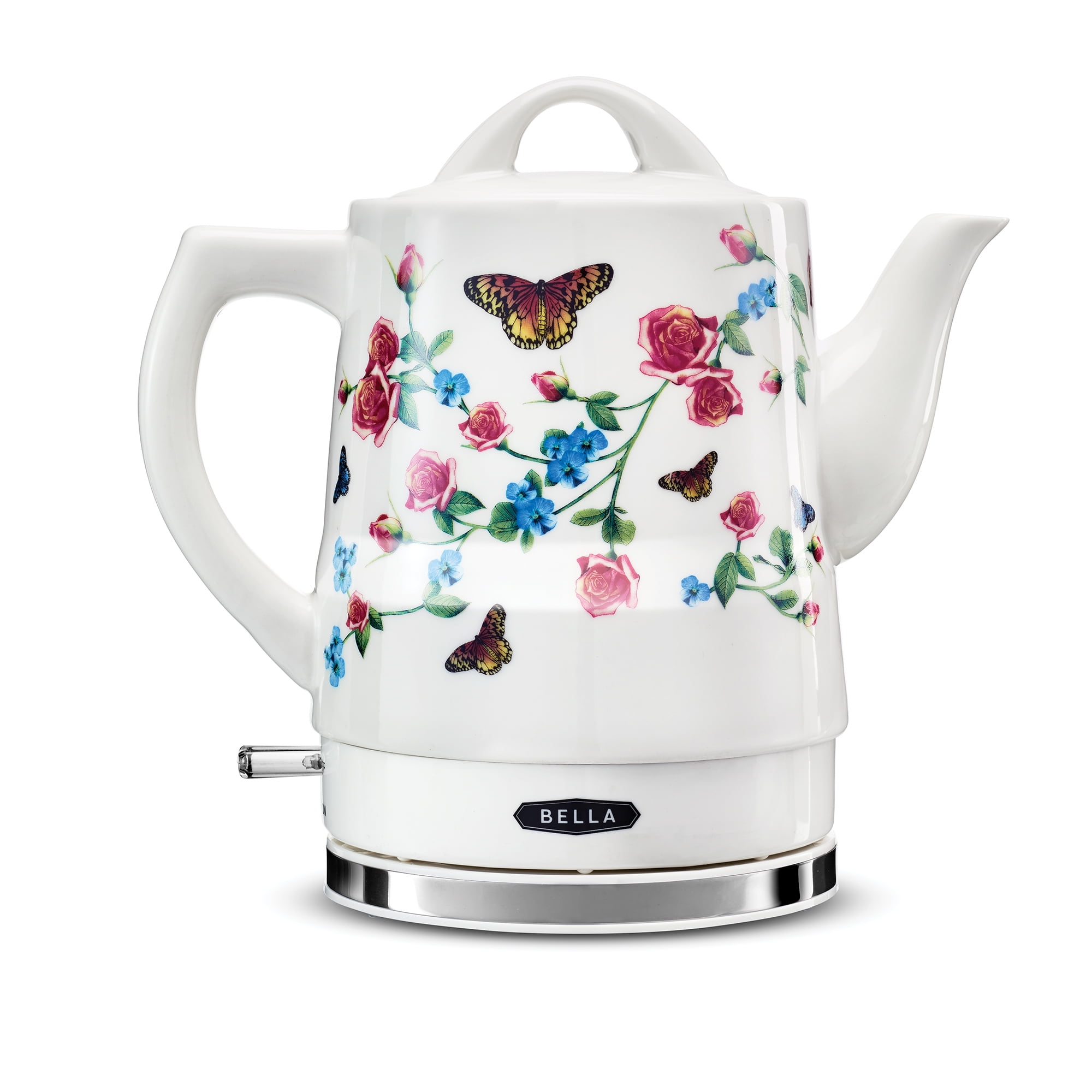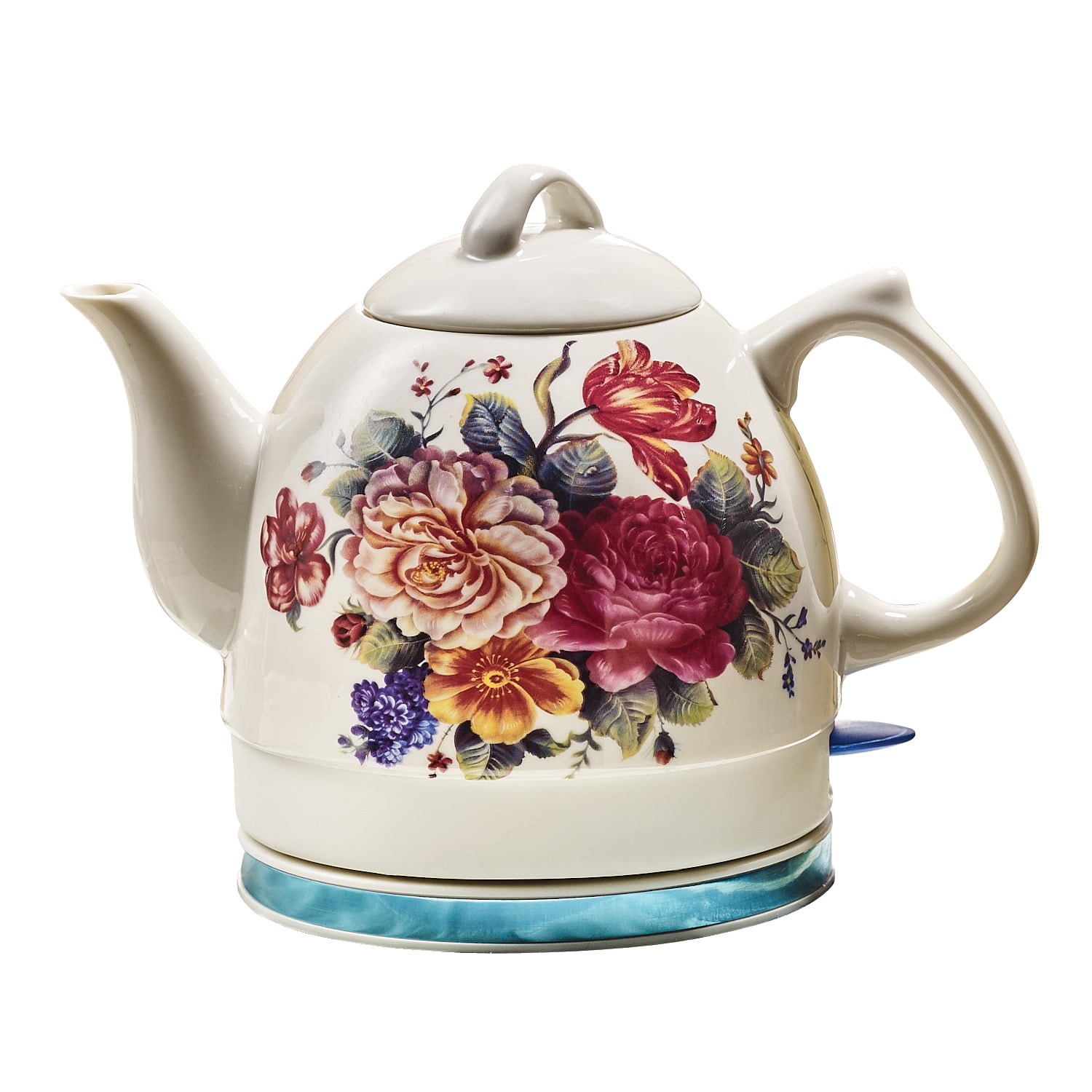As ceramic electric tea kettles grace the culinary stage, they invite us on an aromatic journey where form meets function. These remarkable appliances seamlessly blend the elegance of traditional ceramics with the convenience of modern technology, offering a symphony of style, functionality, and flavor.
From the intricate patterns that adorn their exteriors to the advanced features that enhance their performance, ceramic electric tea kettles are a testament to the ingenuity and craftsmanship that define our contemporary kitchens. Join us as we delve into the captivating world of these exceptional tea kettles, exploring their construction, features, and the myriad ways they elevate the tea-making experience.
Materials and Construction
Ceramic electric tea kettles are made from various types of ceramic materials, each with unique properties and characteristics. The most common types of ceramic used include:
- Porcelain:Porcelain is a fine-grained, non-porous ceramic known for its durability, heat resistance, and ability to retain heat.
- Stoneware:Stoneware is a denser, more durable ceramic than porcelain. It is less porous and has a higher resistance to thermal shock.
- Earthenware:Earthenware is a porous ceramic with a lower firing temperature than porcelain or stoneware. It is less durable and heat resistant but offers a more rustic appearance.
The manufacturing process of ceramic electric tea kettles typically involves the following steps:
- Forming:The ceramic material is shaped into the desired form using techniques such as casting, molding, or wheel throwing.
- Drying:The formed ceramic piece is allowed to dry to remove excess moisture.
- Firing:The ceramic piece is fired in a kiln at high temperatures to harden and strengthen it.
- Glazing:A glaze is applied to the fired ceramic surface to create a protective and decorative finish.
- Re-firing:The glazed ceramic piece is fired again to fuse the glaze to the surface.
Ceramic construction offers several advantages for electric tea kettles:
- Durability:Ceramic is a durable material that can withstand everyday use and accidental bumps.
- Heat retention:Ceramic has excellent heat retention properties, keeping water hot for longer periods.
- Non-toxic:Ceramic is a non-toxic material that does not leach harmful substances into water.
However, ceramic construction also has some disadvantages:
- Weight:Ceramic tea kettles can be heavier than other types of kettles.
- Fragility:Ceramic is a fragile material that can chip or break if dropped or handled roughly.
- Cleaning:Ceramic kettles can be more difficult to clean than other types of kettles due to their porous nature.
Features and Functionality

Ceramic electric tea kettles come with a range of features that enhance their functionality and safety. These features include:
- Temperature Control:Allows you to set the desired water temperature, ensuring your tea brews at the optimal temperature for its flavor profile.
- Automatic Shut-Off:Automatically turns off the kettle once the water reaches the boiling point, preventing overheating and potential fire hazards.
- Boil-Dry Protection:Prevents the kettle from operating when there is no water inside, protecting the heating element from damage.
Ceramic electric tea kettles are available in various capacities, typically ranging from 1 to 2 liters. They also come in different styles, including traditional, modern, and vintage designs, allowing you to choose one that complements your kitchen décor.
Performance and Efficiency

Ceramic electric tea kettles are known for their efficient and reliable performance. They typically boil water faster than traditional stovetop kettles, thanks to their powerful heating elements. The boiling time can vary depending on the size and wattage of the kettle, but many models can boil a full pot of water in under 5 minutes.Ceramic electric tea kettles are also energy-efficient.
They use less energy than stovetop kettles, as they do not lose heat through the sides of the kettle. This can save you money on your energy bills over time.
Factors Affecting Performance and Efficiency
Several factors can affect the performance and efficiency of ceramic electric tea kettles, including:
- Wattage:The wattage of the kettle determines how quickly it can boil water. Higher wattage kettles will boil water faster than lower wattage kettles.
- Size:The size of the kettle also affects the boiling time. Larger kettles will take longer to boil water than smaller kettles.
- Insulation:The insulation of the kettle can also affect the boiling time. Kettles with better insulation will lose less heat, which can help to reduce the boiling time.
By choosing a ceramic electric tea kettle with a high wattage, a smaller size, and good insulation, you can ensure that you get the best possible performance and efficiency.
Design and Aesthetics
Ceramic electric tea kettles are not only functional but also visually appealing, adding a touch of style to any kitchen. They come in a wide range of designs, colors, patterns, and finishes, allowing you to choose the perfect kettle to complement your décor.
From classic and elegant to modern and minimalist, there is a ceramic electric tea kettle to suit every taste. Whether you prefer solid colors, intricate patterns, or metallic accents, you’re sure to find a kettle that matches your kitchen’s style.
Colors and Patterns
Ceramic electric tea kettles are available in a wide range of colors, from classic black and white to vibrant shades of red, blue, green, and yellow. Some kettles feature intricate patterns, such as floral designs, geometric shapes, or abstract motifs, adding a touch of elegance and personality to your kitchen.
Finishes
Ceramic electric tea kettles can have different finishes, including glossy, matte, or textured. Glossy finishes reflect light, giving the kettle a sleek and modern look. Matte finishes are more subdued and create a more rustic or vintage feel. Textured finishes add visual interest and can complement kitchens with a more organic or natural aesthetic.
Complementary Décor Styles
The design of a ceramic electric tea kettle can complement different kitchen décor styles. For example, a kettle with a classic white finish and simple design can complement a traditional or farmhouse kitchen. A kettle with a vibrant color and intricate pattern can add a pop of color and personality to a modern or eclectic kitchen.
A kettle with a matte finish and textured surface can complement a rustic or industrial kitchen.
Maintenance and Care
Ensuring the longevity and optimal performance of your ceramic electric tea kettle requires proper maintenance and care. This involves regular cleaning, descaling, and following specific usage guidelines.
Regular cleaning is essential to prevent stains, mineral buildup, and unpleasant odors. After each use, rinse the kettle with warm water and wipe it dry with a soft cloth. For more thorough cleaning, use a mild dish soap and a soft sponge to gently scrub the interior and exterior of the kettle.
Avoid using harsh chemicals or abrasive cleaners, as these can damage the ceramic surface.
Descaling, Ceramic electric tea kettle
Descaling is crucial to prevent mineral buildup, which can affect the kettle’s heating efficiency and lifespan. The frequency of descaling depends on the hardness of your water. For areas with hard water, descaling every 1-2 months is recommended. To descale, fill the kettle with a mixture of equal parts white vinegar and water.
Bring the solution to a boil and let it sit for 30 minutes. Rinse the kettle thoroughly with clean water to remove any remaining vinegar or mineral deposits.
Extending Lifespan
- Avoid overfilling the kettle, as this can strain the heating element.
- Never boil the kettle without water, as this can damage the heating element and the ceramic lining.
- Unplug the kettle when not in use and allow it to cool completely before cleaning or storing.
- Store the kettle in a dry place to prevent mold or mildew growth.
Final Review

As we conclude our exploration of ceramic electric tea kettles, it is evident that these appliances are more than mere kitchen tools; they are works of art that seamlessly integrate style and functionality. Whether you are a seasoned tea connoisseur or simply appreciate the finer things in life, a ceramic electric tea kettle is an indispensable addition to your home.
Let the symphony of design, convenience, and flavor fill your kitchen and inspire you to create unforgettable tea moments.
Expert Answers: Ceramic Electric Tea Kettle
What are the advantages of ceramic electric tea kettles?
Ceramic electric tea kettles offer numerous advantages, including durability, heat retention, non-toxic materials, and aesthetically pleasing designs.
How do I clean and maintain a ceramic electric tea kettle?
To clean a ceramic electric tea kettle, simply wipe the exterior with a damp cloth. For the interior, fill it with equal parts water and vinegar, bring to a boil, and let it sit for 30 minutes before rinsing thoroughly.
What is the best way to prevent mineral buildup in a ceramic electric tea kettle?
To prevent mineral buildup, regularly descale your tea kettle by filling it with a mixture of equal parts water and white vinegar, bringing it to a boil, and letting it sit for 30 minutes. Rinse thoroughly before using.